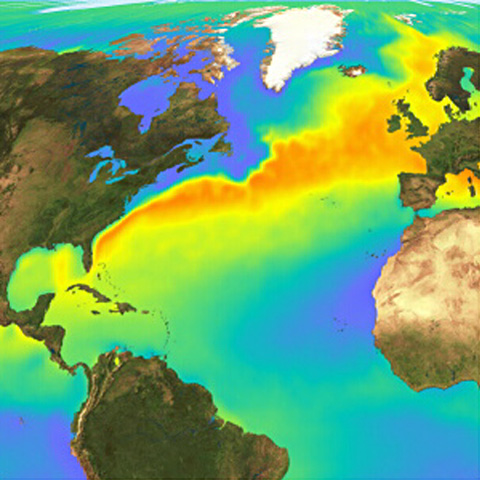In the 2004 movie, The Day After Tomorrow, the normal circulation of the North Atlantic Ocean and the Gulf Stream come to a halt sending the entire northern hemisphere into a new Ice Age that reaches as far south as Mexico and the North African shore.
Fiction or fact?
Fiction in the sense that the suddenness of the change necessary for movie catastrophist-seekers, is a device but absolute poppycock as science goes. But there is a tidbit of truth in that most recent observations show a North Atlantic that is undergoing changes in circulation patterns that could pose an existential threat by the end of the 21st century.
What set off reader concerns? An article appearing in The Guardian in the last week reported about growing evidence of changes in ocean circulation related to global warming. This wasn’t news to those who follow the science of climate change. I know I have written about the relationship between global atmospheric warming and ocean circulation patterns on this blog site a number of times.
Almost from the beginning of the blog back in 2009, climate change in the form of rising atmospheric temperatures and the subsequent impact of the increases on the world’s oceans has found a place on the pages written here. In 2016 I reported on research published in the Journal of Geophysical Research: Oceans, where a study stated global warming was pushing the Gulf Stream poleward.
In that same year I wrote about Dr. James Hansen, a former NASA scientist, who produced a paper that used climate simulations, paleoclimate data, and observations of ice melt in Antarctica and Greenland, to predict a slowdown and eventual shutdown of the Atlantic Meridional Overturning Circulation (AMOC), impacting the Gulf Stream.
Hansen’s modeling has given way to real-time data that supports his thesis. North Atlantic circulation is demonstrably getting weaker and causing changes to weather patterns across the pond in Europe and the UK. And what that means is more extreme weather events from intensely cold outbreaks to warmer than normal periods. These extremes aren’t limited to Europe. Just witness what occurred in North America recently when a polar vortex caused the power grid in Texas and other southern U.S. states to fail, leaving people in their homes freezing in the cold.
Feeding new data into climate models created at the Potsdam Institute (Germany), Maynooth University (Eire), and University London (U.K.) supports the conclusion that the AMOC has slowed by 15% in recent years and will continue to do so as global atmospheric temperatures rise.
In The Guardian article, it quotes Stefan Rahmstorf, of the Potsdam Institute who forecasts a reduction of between 34 to 45%, considered close to a tipping point that could lead to irrevocable instability. States Rahmstorf, “In 20 to 30 years [AMOC] is likely to weaken further, and that will inevitably influence our weather, so we would see an increase in storms and heatwaves in Europe, and sea level rises on the east coast of the U.S.”
Rahmstorf’s conclusions about sea-level rise take into consideration the thermal expansion of the warming Gulf Stream and North Atlantic along with the natural left-to-right ocean circulation pattern (influenced by the Earth’s rotation) observed in the Northern Hemisphere. This causes ocean water to pile up on the left side of a current in the Northern Hemisphere, which accelerates local sea-level rise and is one of the causes of sunshine day flooding that is becoming far more common in Florida cities like Miami. For more on that you can read the article posted on this site earlier in the week that talks about the perils and plans of South Florida to combat rising sea-levels over the next 40 years.
The Guardian article describes the AMOC as one of the largest ocean circulation systems on our planet with plenty of evidence of its constancy in the past from sediment, ice core, and weather data studies. Rahmstorf and team believe AMOC’s weakening is not yet at the point of collapse witnessed in The Day After Tomorrow, but it is a warning. He states:
“We risk triggering [a tipping point] in this century, and the circulation would spin down within the next century. It is extremely unlikely that we have already triggered it, but if we do not stop global warming, it is increasingly likely that we will trigger it. The consequences of this are so massive that even a 10% chance of triggering a breakdown would be an unacceptable risk.”









